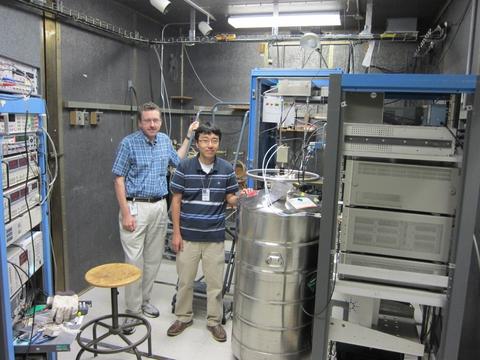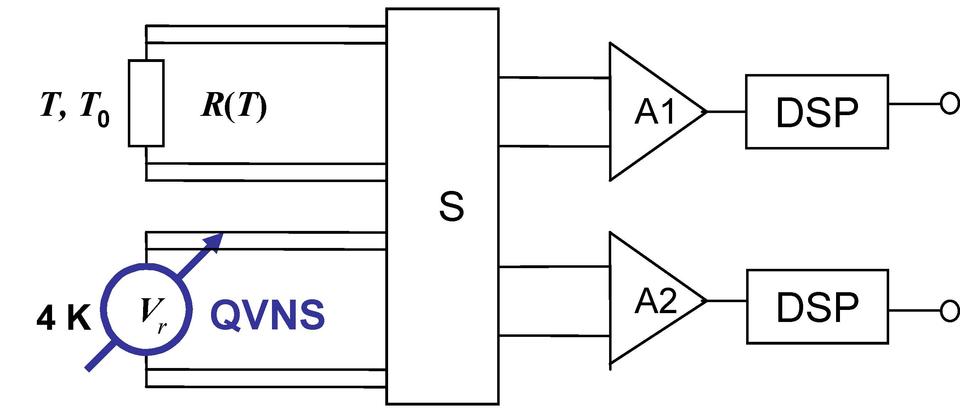Summary
Johnson noise thermometry (JNT) is a primary temperature measurement technique based on the fundamental properties of thermal fluctuations in conductors. We measure these fluctuations with respect to quantum voltage noise sources (QVNS). The results are useful for both temperature scale metrology and for the development of reliable thermometers for harsh environments. The NIST-developed spectral JNT methods link the measured thermal voltage directly to the as-maintained electrical units via the AC Josephson Voltage Standard. This new methodology conveys key advantages from a metrology standpoint and will extend the practical application range for JNT systems.
Description

Inside the NIST Shielded Room used for JNT on the Gaithersburg, MD campus.
The NIST Gaithersburg JNT project produces data useful for verification of the International Temperature Scale of 1990 (ITS-90) over a temperature range from 500 K to 930 K. This range overlaps those covered by other thermodynamic methods, most notably the upper-most range of Acoustic Thermometry and the lower-most range of absolute Radiation Thermometry. The JNT results provide independent data for scale validation in these overlapping ranges. We expect future impacts in advancing the application of JNT temperature measurements in new demanding environments, such as high-temperature nuclear reactors.
Objective
To obtain data on JNT temperatures with respect to the ITS-90 in these important overlapping ranges with uncertainties comparable to the best Radiation Thermometry methods.
Technical approach
We apply new technologies and methodologies to JNT using wide-band spectral analysis, digital signal processing, and pulse-quantized voltage synthesis. The new NIST JNT methods directly compare measured thermal noise voltages to an AC Josephson Quantized Voltage Noise Source (QVNS) (see Figure 1). The QVNS as developed at NIST Boulder can synthesize arbitrary waveforms with an accurate rms amplitude matched to that of a Johnson noise source, resulting in a calculable noise source reference. In the absolute measurement mode, the noise power of the QVNS is programmed to balance that of a thermally generated Johnson noise source, resulting in a thermodynamic temperature independent of any fixed-point reference. In the relative measurement mode, the process is repeated at another temperature and another synthesized noise power, resulting in a thermodynamic temperature ratio. Both methodologies represent a significant advance over conventional JNT methods, which have less flexibility and functionality. Specific advances of the NIST JNT systems are:
- high resolution (~1 Hz) spectral densities with a bandwidth approaching 1MHz;
- application of the fastest available Fast Fourier Transform (FFT) subroutines for near-realtime processing;
- frequency domain cross-correlation analysis;
- QVNS synthesized pseudo-noise waveforms of matched spectral densities;
- ultra-low noise and high common-mode rejection pre-amplifiers;
- simultaneous matching of both noise powers and time constants.

The QVNS is balanced to match the noise power of the sensor resistance R at an unknown temperature T. The inputs to two identical amplifier chains A1 and A2 are alternated via a switching network S. The amplified signals are digitized and filtered via the digital-signal-processing (DSP) elements and optically coupled into memory for FFT processing and storage.
Major Accomplishments
- 2007: Two publications report our results at 693 K using both QVNS-based and thermal-based noise references. The two results agree well within their combined uncertainties of 40 µK/K.
- 2010: Achieved 40 µK/K uncertainty with QVNS-based system in absolute mode at 505 K and 693 K and 28 µK/K uncertainty at 693 K in relative mode.
- 2013: Published new results from 600 K to 800 K achieving uncertainties of 33 µK/K.
- 2017: Published a final value for the Boltzmann constant with an uncertainty of 5 µK/K.

